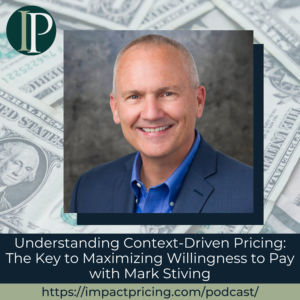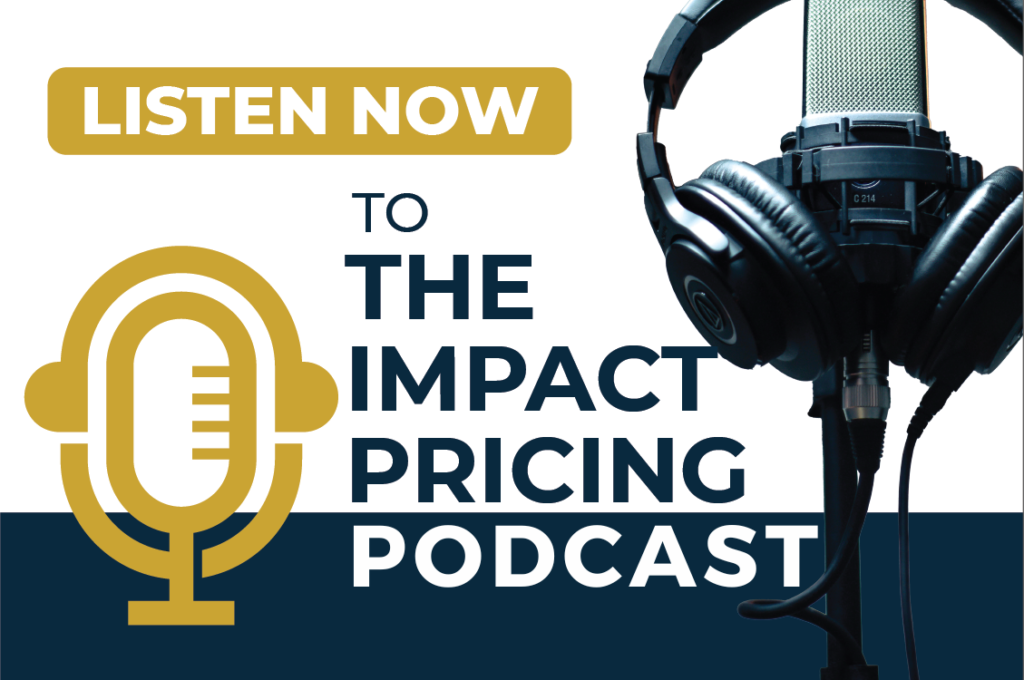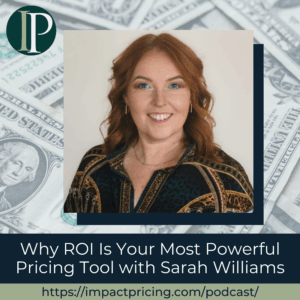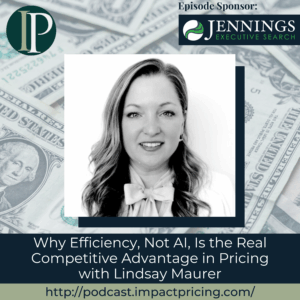Mark Stiving is a pricing expert and the host of the Impact Pricing podcast, where he explores the intricate relationship between pricing, value, and context. With a wealth of experience in pricing strategies, Mark is passionate about helping companies maximize their revenue through effective pricing techniques.
Steven Forth is the co-founder and Managing Partner at Ibbaka, a leading pricing strategy consultancy. With deep expertise in B2B SaaS pricing and value-based pricing models, Steven has been at the forefront of pricing innovation for over two decades. He’s passionate about the intersection of pricing strategy, customer value, and emerging technologies like AI agents.
In this episode, Steven turns the tables on Mark to explore context-driven pricing – Mark’s revolutionary framework that’s changing how pricing professionals think about willingness to pay. Together, they dive deep into the four contexts that drive every pricing decision, the three-layer business framework that organizes pricing strategy, and why perfection is the enemy of progress in pricing.
Podcast: Play in new window | Download
Why you have to check out today’s podcast:
- Discover the concept of context-driven pricing and its significance in today’s market.
- Learn how different contexts, such as environmental and customer factors, influence pricing decisions.
- Understand the importance of defining the problem to effectively implement pricing strategies.
“Willingness to pay is contextual.”
– Mark Stiving
Topics Covered:
01:37 – What motivated Mark to think about Context-driven Pricing?
03:15 – The four categories of context: problem, customer, behavioral, and environmental.
04:52 – How environmental factors influence willingness to pay?
06:01 – The role of competitors in shaping pricing strategies.
08:13 – Understanding the foundational problem and its impact on pricing decisions.
14:01 – The intersection of context-driven pricing and AI.
24:58 – Key takeaways on implementing context-driven pricing effectively.
Key Takeaways:
“Pricing is about understanding the context in which a buyer operates.” – Mark Stiving
“Defining the problem is crucial to determining willingness to pay.” – Mark Stiving
“Perfection is impossible; focus on being better every day.” – Mark Stiving
Resources and People Mentioned:
- Steven Forth: https://www.linkedin.com/in/stevenforth/
- Ibbaka: https://www.ibbaka.com/
- Craig Zawada: https://www.linkedin.com/in/craig-zawada-a0a39029/
- Pros: https://pros.com/
- Stephan Liozu: https://www.linkedin.com/in/stephanliozu/
- Zilliant: https://zilliant.com/
- Gabe Smith: https://www.linkedin.com/in/gabesmith/
- PriceFX: https://www.pricefx.com/
Connect with Mark Stiving:
- LinkedIn: https://www.linkedin.com/in/stiving/
- Email: [email protected]
Full Interview Transcript
(Note: This transcript was created with an AI transcription service. Please forgive any transcription or grammatical errors. We probably sounded better in real life.)
Mark Stiving
Anything that explains why one buyer is willing to pay a different price than another buyer, this is context.
[Intro / Ad]
Mark Stiving
Welcome to Impact Pricing, the podcast where we discuss pricing, value, and the contextual relationship between them. I’m Mark Stiving, and I run boot camps to help companies get paid more. Our host today is Steven Forth. I’m just going to hand it over, Steven. It’s all you.
Steven Forth
Great. Well, thank you very much, Mark. And it’s nice to be able to turn the tables on you for a change. The reason we’re here is that there has been a lot of change happening in pricing circles. And there have been some really critical new ideas and new ways of thinking about pricing surfacing.
And one of the ones that I’m really excited about is this thing called Context-driven Pricing, which originates with you. And you’ve been sharing a lot of ideas about it. And I’ve been thinking hard about it and starting to apply it to the work that I do in my company Ibbaka does on the design of pricing. So what I’d like to do today is really understand what context-driven pricing is. Before we dive into that though, where did this come from? What motivated you to start thinking about context-driven pricing?
Mark Stiving
It’s you and every other pricing expert in the field. I would go on LinkedIn and I would ask the question, what is value? Because I am a huge fan of value-based pricing. I dearly love value-based pricing, but we could never agree on what value means. And I could give you three or four definitions, which I think are really reasonable definitions for what we do as pricing folks.
And it’s like, I need something to say, here’s the strategy that really matters. And so, what’s the strategy that really matters? It’s, charge what someone’s willing to pay, period. Now I’ll give you a little nuance behind that as well, but I think that the optimal price is charging what a customer is willing to pay.
Now, what’s the name of that? Calling it willingness to pay pricing seemed really horrible. Different people are willing to pay based on different situations or what, you know, in essence, context. And so, after just thinking about it for way too long, context-driven pricing came to us and we’re like, oh, that’s a great name for this. So, I created context-driven pricing so I could define it. And I defined it as, charge what a customer is willing to pay.
Steven Forth
Okay, so let’s peel off a layer here. I’m going to put aside the whole conversation about value and willingness to pay for a moment. We may come back to it. But where I’d really like to focus in on is context. So when you say context, what are some of the different contexts that you have in mind that provide, dare I say it, the context for context-driven pricing?
Mark Stiving
Yes. Well, first off, let’s define context in this world of context-driven pricing. And I think of context as anything that explains why one buyer is willing to pay a different price than another buyer. This is context.
And so, I’ve categorized context, and whether someone else categorizes it differently is totally fine, but I’ve crafted four different contexts that I think of that matter. And I do this not because I think you have to be able to categorize a context, but it helps you think through the context. What are the contexts that I might be missing?
And so, the four categories that I’ve crafted are problem, and the problem in my mind is the single most important concept. I’m sure we’re gonna talk about that as we go through this.
And then the other three are customer. So tell me something about the buyer, something about the customer. So these could be demographics, it could be psychographics, whatever it is we wanna make it.
Behavioral, so how is it that they go about their shopping behavior? How much do they search?
And then the last one is the one that you would probably expect, and that’s environmental, right? What’s the weather like? What’s the economy doing? What did the competitors do?
So there’s four different categories of context that we could think of. And to me, the answer is whatever influences somebody’s willingness to pay.
Steven Forth
So let’s unpeel those contexts a bit more, those different contexts. And I’m going to start at the end and work my way back to problem, if I may. So the environment, how does the environment change and shape willingness to pay?
Mark Stiving
Oh, that’s easy. So let’s, in most of these, there’s two different types of contexts. So let me split most of them up into, I’m going to call them stable and fluctuating because it kind of changes the way you think about it.
And so, let’s talk about environment, and we’ll do a stable context first. People in Minnesota are willing to pay more for a snowblower than people in Texas. Why is that? Because the climate’s different, right? So that’s a context that drives willingness to pay.
Let’s talk about fluctuating. In Minnesota, people are probably willing to pay more for a snowblower in the winter than they are in the summer, right? This is context again. And so, what is the context of selling a snowblower? I’d rather sell them in the winter in Minnesota at higher prices. And if I have to put them on discount, I’ll do that in the summer.
Or if I could get someone in Texas to buy one, heck, in fact, I’d probably have a different type of snowblower, right? A really small one that was easy to use. And, you know, maybe I could get someone to give me a few hundred bucks for it.
Steven Forth
Can you say a little bit more about competitors as part of the environment?
Mark Stiving
So competitors, you could fit that as most of the things I talk about, you could fit that in a different category as well. So I might put that in the behavior category as in, as a shopper, am I looking at a competitor or not looking at a competitor?
But from a contextual point of view, let’s talk about international pricing for a second. I might be selling something in the US where there are a lot of competitors for something. And then I turn around and I sell it someplace else, and there are very few competitors for it.
And so, that’s very contextual as what does the environment look like? What does the market look like in that situation versus a different situation?
Steven Forth
So using the stable versus fluctuating frame that you said, Can you give us some examples of a stable competitive environment versus a fluctuating competitive environment?
Mark Stiving
I don’t know that I’ve thought of that, but let me, let’s do one real quickly, right. I mean, so stable is obvious, right? It’s the market. How many competitors are in the marketplace. Fluctuating? Oh, here is, this is a great one. Your competitor just lowered their price. What are you going to do now, right? So that’s a fluctuating context.
Steven Forth
Okay. And that’s one of the things that will help determine willingness to pay.
Mark Stiving
Sure. So if I’m looking as a shopper, if a shopper is looking at two different alternatives and both of them are, you know, around $100. And then all of a sudden one of them lowers their price to $80, guess what? That influences my shopper’s willingness to pay.
Steven Forth
Yeah. It reminds me a little bit of, you know, the old pricing concept that we use all the time of cross price elasticity. The tendency of a buyer to switch vendors depending on the price.
Mark Stiving
Yep. No, that’s exactly right. And you’ve probably heard me talk about ‘will I’ and ‘which one.’ In my world, that’s the ‘which one’ decision, right? Whose am I going to go buy?
Steven Forth
Yeah. And the ‘will I’ is, well, actually, you know, the ‘will I’ and ‘which one’ is an important part of some of your other work that you’ve used to train pricing GPT. Put the sort of ‘will I’ and ‘which one’ frame onto context-driven pricing if you can.
Mark Stiving
Okay, so this is actually going to take us a little while to get there, if that’s okay, Steven.
Steven Forth
Sure.
Mark Stiving
So the first thing I want to mention is that, let me tell the story this way. How much should Uber charge? Well, I don’t know, it depends, right? Well, what does it depend on? Well, it depends on a lot of different things, but the first thing it depends on and the highest level problem it depends on is, what market segment are we going after?
So are we talking about Uber people, right? So when you and I take an Uber somewhere. Are we talking about Uber Eats when they deliver food? Are we talking about Uber Connect when they deliver packages for businesses? Those are three very different market segments. They solve very different problems.
I call these foundational problems, right? So what is it? Why would you ever buy something from Uber? Well, because I need to get from my house to the airport. That’s a foundational problem. And it turns out that is the ‘will I’ decision.
Once you pick any one of those market segments, you step into what I’ll call the problem scope. right? What’s the product portfolio that we’re gonna use to address a problem scope? So now we go to Uber and we’ll talk about Uber people, right? We’ve got UberX and Uber Rideshare and UberComfort and UberXL. And I live in Reno, it’s UberSki here in the winter time, right?
And so, they’ve got these different products to manage different scopes. And as a buyer, I’m gonna take a look at the context of what’s the problem I’m trying to solve now. as I’m trying to choose which one of those alternatives I want for that product portfolio.
By the way, you could put Lyft in that list. So now we’ve got, am I going to choose Uber or am I going to choose Lyft? Because I want to know what’s the best way to solve the problem that I have right now.
Now let’s go one more layer deeper. So we started out with market segments, product portfolio, now we’re gonna go to price segmentation. So at the level of price segmentation, I wanna get from my house to the airport, are there any environmental conditions that impact how much I’d be willing to pay for that?
So it’s Christmas time, there’s no parking at the airport, I need to leave at four in the morning, how much do you wanna charge me? I’m just gonna pay whatever it is. And so, there are these factors that say, hey, we could adjust our prices based on environmental conditions at the price segmentation level.
So we think of those three layers, I think of those three layers, as layers of context. So you’ve got a foundational problem, you’ve got the problem scope, and then you’ve got the situational context.
I also think of those as three different business decision layers, right? So at the top, you’ve got market segments. The next layer down, you’ve got the product portfolio, and your pricing metric goes in that section. And the layer below that is price segmentation. How are we actually gonna get a price to a customer?
So the ‘will I’ and the ‘which one’ fit. ‘Will I’ is at the top, ‘which one’ is in the middle? And then at the bottom, you could almost argue, that’s just willingness to pay, right? Given that I’ve already made a choice that I’m going to buy this thing, how much am I going to pay for it?
Steven Forth
So Mark, listening to you, this reminds me a little bit of listening to someone like Craig Zawada at Pros or Stephan Liozu at Zilliant or Gabe Smith at PriceFX. who are always talking about dynamic pricing and the different factors that determine the dynamic price that their pricing recommendation engine is going to suggest to the salesperson.
How would you compare and contrast context-driven pricing with the dynamic pricing approaches that have been developed by the big old heavy metal vendors over the last couple of decades, really?
Mark Stiving
Yeah. So when I think about the pricing systems, the pricing software companies, the experience I’ve had with them is, usually they just, I don’t mean to demean it at all, right, but they input a ton of transaction data. And they try to make sense of it to say, oh, this quote is like these other customers that bought at these prices, so therefore we should quote at this price.
And so, they’re doing micro-segmentation. I haven’t seen them go back and say, oh, well, we do different micro-segments for this market segment than we do for this market segment.
Steven Forth
I think they may be doing that. I think it might be better to get one of those guys on and go through their approach with them. Because I’m, to me, one of the push backs against the dynamic pricing optimization is they’re a bit of a black box.
And I’ve never met a buyer who responds happily to the statement, my pricing optimization system says you should be willing to pay X, therefore I’m going to charge you X. That’s not going to be a productive conversation.
And what context-driven pricing is doing is it’s exposing the reasoning behind that. It’s opening up the black box and making the black box understandable.
I’d like to just make a quick side to detour here before we go to problem.
So one of the big themes in artificial intelligence over the last few years has been explainable AI. That the AI needs to be able to explain the recommendation it’s giving or the advice it’s giving or the contents, whatever it’s doing.
Do you see context-driven pricing as a way to help generative AIs explain the pricing advice that they’re being asked to give?
Mark Stiving
Possibly, here’s how I actually see the intersection with AI and context-driven pricing, right? I see that context-driven pricing is really hard, right? I mean, you could look at any individual and say, how much would you be willing to pay for something? And it’s just, you know, we can’t read someone’s mind. It’s gonna take a lot of processing power to figure that out.
So could we put structure behind this so that we have a way to think about it? And in reality, that’s why I crafted that value architecture I just described to you, is because these are decisions that companies have to make and here’s how it fits with this world of context.
But on the other hand, context-driven pricing, I think it guides AI into how to make pricing recommendations, right? As opposed to, can I use CDP to explain AI or AI recommendations. It’s, can I use AI to help implement context-driven pricing?
And I think that’s really what’s gonna happen, is that, if people want to adopt context-driven pricing, then we can start to layer on how is it that we can find those foundational problems? How is it that we define the problem scope? How is it that we define the willingness to pay for a given product in a given situation?
And that will be explainable because what we’re doing isn’t putting a price on something because you look like those other people. What we’re really doing is we’re putting a price on something because we understand the context.
Steven Forth
So you mentioned problem in that, and that’s where we started, right? As you know, the four contexts are the problem context, the customer context, the behavioral context and the environmental context. I’d like to jump all the way up to problem now.
You know, other people have been looking at jobs to be done as a way of informing a pricing. At Ibbaka, we’ve been doing that in a couple of ways. We used jobs to be done as, you know, one layer of our agent pricing layer cake, something we’ve discussed in the past.
And we also used it to generate a concept blend of B2B SaaS and jobs to be done in the context of pricing and AI agents and jobs to be done in the concept of pricing. How does context-driven pricing use the idea of jobs to be done, or is that a separate sort of area for you?
Mark Stiving
So I am going to say three magic words. I don’t know.
So I had problems ingrained in my head when I was instructing with pragmatic marketing. This was a long time ago, right? And so, I have always thought about problems. And then, you know, I read Clayton Christensen, Jobs to be Done, and I could never say, what’s the difference between jobs to be done and problems?
And I would ask people and they would give me answers that I never thought was right. And, you know, it wasn’t clear. So to me, they’re very, very similar concepts. To me, I can deal with problems because I understand problems and I understand results.
So my third book was called Selling Value. And in Selling Value, I defined something I called a value table. And to me, a value table is what’s your solution. So it could be your product or feature. What’s the problem it solves? What’s the result someone gets when they solve that problem?
And then in B2B, how much money are we going to make someone because they solve that problem and got that result? So it’s a really easy way for me to articulate what is value in a B2B world. And so, I’ve always thought that way.
Steven Forth
So, Mark, would it be fair to say that one of the key skills in being able to do context-driven pricing is to be able to do a really good job of defining the problem?
Mark Stiving
Oh my gosh, yes. And what’s fascinating about it is that as soon as you see two people with different willingness to pay, what you know is that there’s a different problem there. Now, it could just be the size of the problem. It could be how much they care about the problem. But it is all about the problem at that point in time.
Steven Forth
So how do you go about uncovering and defining the problem? Is there a good way to do that?
Mark Stiving
So this is hard. First off, let’s articulate that there are layers of problems. One of my favorite examples that I use is Ted Levitt once said, nobody wants to buy a quarter-inch drill. What they want to buy is a quarter-inch hole.
Turns out, absolutely nobody wants to buy a quarter-inch hole. What they really want to do is buy the ability to hang a picture over their fireplace. Well, actually, they don’t really want to hang a picture over their fireplace. They really want a nice-looking living room. So we could take layers of problems.
Now, how do we find that right layer of problem? There is no one single answer as to what’s the problem that we’re going to go address, we’re going to go market to, or we’re going to price for. We need to understand what’s that layer for any given customer.
So again, it’s very contextual. How are they going to think about it? How are we going to think about it? And how can we make it big enough that it’s a market segment if we’re going to talk about it, right? That it’s enough people that it makes sense for us to talk about.
So here’s how I typically do when I work with my clients, most of them are B2B clients. What I do is I ask them to list 10 customers, different customers. And I ask them to list 10 or more features of their product. I typically call them marketable product features. So you built these because they solved a problem for a customer.
And then on a scale of zero to five, how much does each customer value each feature? So now take a look across any given row and there’s some zeros and there’s some fives. Why? That’s what starts to point out what’s the problem, right?
Now we’re going to dive down into, can we truly define that problem? Can we truly articulate what’s going on? And they’ll say something like, well, they’ve already got a solution or, you know, they don’t do it this way. Great. We’re learning what the problem is for the people who value it.
Steven Forth
So given the centrality of understanding the problem and defining the problem to context-driven pricing, but also to marketing as a whole and product design as a whole, is there any way to use AI to help us to better understand and better define problems? Or is there any way that you can get a prompt to help you do this?
Mark Stiving
Is that a softball, Steven? I’ve been working on it, truly I have. And I’ve got a special way to write problems. So when I write a problem statement, I want it to be in first person. So as though you’re talking, as though it’s your customer talking, right?
I want it to not have anything to do with the solution in the problem statement. And I want it to have some emotional impact or negative impact that makes it feeling, makes it worthwhile. So it’s not just a fact.
And so, what I did was I did craft a small mini agent in my pricing GPT. And so today, if you go in there and you type pricing colon, and I’m about to change it to comma pricing, but if you type pricing colon, and then you write a problem statement, whatever problem statement you want, it’s gonna analyze your problem statement. And it’s gonna say, yeah, that’s not how Mark would have done it.
And then it’ll rewrite it for you. And then it’ll also write two other ones for you. It’ll write one at a higher level, and it’ll write one at a more specific level. Now, they’re not the right answers for you, right? We don’t know exactly who the persona was, who the customer was, what the product was, but it gives you a way to say, hey, what do I think the problem statement could look like?
And then it also, at the end of that, it gives you a few results. So think of results as KPIs if you’re selling a B2B problem. What are some KPIs that we might be able to measure if we solve that problem? And so, it’s just a nice way to start to think deeper about what’s the problem you’re really trying to solve.
Steven Forth
Just want to, again, go a little bit out in left field here. As you know, there has been a lot of talk about AI agents and an agent economy and, you know, a major shift in how software functionality gets packaged.
How could we apply context-driven pricing, including the notion of problem definition, to understanding what sorts of agents we should be building and taking to market?
Mark Stiving
Well, I wish I knew the answer to that question, Steven. I struggle still with understanding what agents really are or how to build an agent. I’ve used agent.ai to try to build an agent and it was okay, but not fabulous. This thing I just described to you, I think could be called an agent. Not a hundred percent sure.
Steven Forth
I would call pricing GPT an agent.
Mark Stiving
Would you? Okay.
Steven Forth
Yeah, and agents can have sub-agents, so the pricing colon piece of it then becomes a sort of sub-agent within the content. But I think one of the…the things that a lot of people are struggling with today is they have an existing software application. And my world is largely in B2B enterprise software.
So they have an existing software application. It’s become large, it’s complex. The user interface has a lot of dimensions to it. And they’re struggling to understand, okay, how could I decompose this into a problem that I can design a specific agent to solve? That’s sort of central, I think, to the shift to the agent economy.
Mark Stiving
Yeah, so I don’t know. I have not figured out how to get AI to answer that question for me yet. It feels to me like it’s a skill that I use when I work with clients so that I could say, no, that’s not the problem. This is a problem over here. And we start to get there. But I’ve had a hard time getting AI to give me the right answers.
Steven Forth
I’m not worried so much about having AI answer this question as to getting answers to the question as to what’s a well-defined problem so that one can then design an AI to help solve that problem.
Mark Stiving
I think we’re in the design thinking world. This is your world, not mine. So I think about the highest level problems. We’re back to the foundational problem, the ‘will I’ decision. Am I solving a problem that someone’s willing to pay me money to go solve?
Steven Forth
So Mark, we’re coming to the end of our time on this. What are sort of three critical things that people should be aware of and take away as they think about context-driven pricing? What are the three critical things that you would like people to be aware of and remember when they hear context-driven pricing?
Mark Stiving
So you and I have talked about the first of three tenets in context-driven pricing. And the first tenet is willingness to pay as contextual. And what we need to be doing is thinking really hard about, what’s the situation any given buyer is in? And how can they make the best decision for themselves while we’re capturing the value we’re delivering to them, right? So to me, that’s number one.
The second tenant to context-driven pricing is willingness to pay is malleable. And so, each of the things that we talk about, hey, you know, I’ve got this problem for this specific situation. I can educate customers. I can help customers realize that there’s way more value here than they thought there was. And the more value they realize, the higher they’re willing to pay. And so, now I can adjust that.
And the third tenet that I would give you, it’s almost like a throwaway tenet, but it is so important. Perfection is impossible. Stop trying to be perfect and be better. Be better tomorrow than you are today. That’s probably the most important of the three tenets, but it’s also the easiest one to do.
Steven Forth
Well, Mark, I look forward to many more conversations about context-driven pricing and far more important, I look forward to finding ways to apply it and apply it, not just in pricing, but also in decomposing existing applications to figure out what problems they solve, how they can help better define contexts, and then building agents to solve them. And of course, pricing those agents.
I appreciate you’re giving me the opportunity to do this and turn the tables on you. So, thank you. And now, go make an impact!
[Ad / Outro]

















